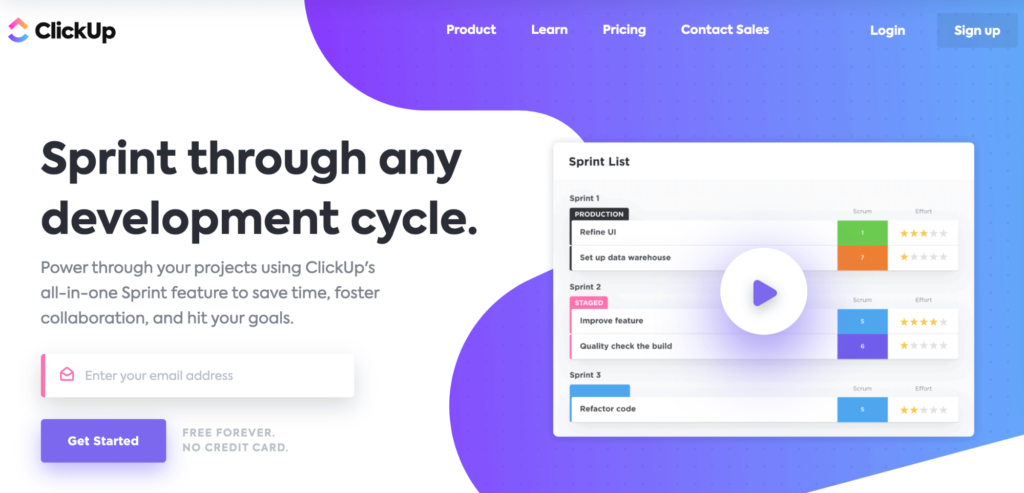Everyone in the project management space has heard of Scrum. But even though this project management methodology is so popular, there’s a lot of confusion surrounding the term.
If you’re considering implementing Scrum with your team and projects, you need to have a firm grasp of how it works.
This guide will walk you through everything you need to know about using the Scrum methodology for a wide range of projects.
What is Scrum Project Management?
Scrum is a project management framework within the agile methodology. It’s designed to help teams improve the way they work together through autonomy, organization, and self-reflection.
The scrum management methodology is built for complex projects, like software development.
This framework is intended for smaller teams led by a “Scrum master.” All of the work is completed in short cycles, referred to as “sprints,” and the team meets quickly on a daily basis to identify tasks and roadblocks.
3 Tools to Improve Scrum Project Management
Scrum project management won’t be useful if you’re not leveraging technology to your advantage. These are the three tools that every Scrum master should consider using to ensure success for their teams:
#1 — ClickUp
ClickUp is trusted by 200,000+ teams across the globe. This includes big names like Uber, Google, and Booking.com. What makes this software unique compared to other tools on the market today is its robust functionality. It’s more than just a platform for managing your Scrum projects; ClickUp is an all-in-one solution for productive work. The tool is designed to replace other apps for things like team chat, goal planning, task lists, and more.
In terms of Scrum projects, ClickUp has a dedicated feature set for managing and planning new sprints. It’s easy for anyone to assign dates, designate priorities, and automatically move unfinished work into the next sprint. Scrum masters have full control over the entire team’s workload. It’s easy to sort tasks and subtasks by role and view everyone’s progress at-a-glance. The tool comes with burndown charts, burnup charts, cumulative flow workload reports, velocity metrics, and more. The basic version of ClickUp is free for unlimited users. But I strongly recommend the premium version. At just $5 per user per month, it’s tough to beat that value. Learn more.
#2 — Jira Software

Scrum is popular among software development teams, and Jira by Atlassian is built specifically for this use case. If you’re managing an agile development team using the Scrum framework, Jira Software should definitely be on your radar. The tool has everything your team needs to plan, track, and release high-quality software. You can use it to plan sprints, create user stories, and assign tasks to everyone on your team. The software makes it really easy for managers to prioritize tasks and collaborate with total visibility. Everyone can view the status of tasks, sprints, and projects with real-time visual data charts.
I like Jira because it comes with pre-built workflows, which can save you a ton of time when you’re first getting started with Scrum. With that in mind, you can use this tool to create a completely customized workflow to match the way your Scrum team works. Jira’s functionality can be extended with 3,000+ apps in the Atlassian marketplace. The software is trusted by 65,000+ businesses worldwide, including technology leaders like Spotify, Airbnb, Square, eBay, and Cisco. Jira is free forever for teams of up to ten users. Paid plans start at just $7 per user per month, and you can try it free for seven days.
#3 — Trello

Trello is one of the most popular project management tools on the market today. That’s why 1+ million teams across a wide range of industries rely on this solution. Compared to other tools, Trello shines due to its simplicity. At its core, it’s a basic Kanban-style board for project management. But the software can easily be manipulated to handle the requirements of a Scrum team.
For example, Trello comes with sprint board templates, sprint retrospective templates, and product backlog templates as well. You can also add-on plug-ins and power-ups to bring essential Scrum functionality into your team’s workflow. Use Trello to create custom columns and color-code tasks based on priorities. If you and your team are new to Scrum, you might find other tools to be too confusing or complex. But Trello is easy to figure out, even for non-technical users. The basic version of Trello is free, and paid plans start at just $10 per user per month. Try it free for 14 days.
The Basics of Scrum Project Management
Like other project management methodologies, there are specific components of the Scrum framework that apply to all Scrum projects. This section will explain each one in greater detail.
Scrum Roles
First, you need to understand how a Scrum team is arranged. Scrum teams must be highly flexible, cross-functional, and adaptive to change. These teams are typically made of 5-11 people segmented into three clearly defined roles—product owner, Scrum master, and development team.
- Product Owner — The product owner is ultimately in charge of the business end of the project in question. As a primary stakeholder in the project, it’s the product owner’s job to clearly communicate the vision for the final product. The product owner is also responsible for establishing the product backlog requirements for the team. The backlog will contain a list of features with a brief description of the functionality required for each one. Product owners need to delegate tasks and responsibilities to the rest of the team without worrying about micromanaging how things are done. This person will also be a resource for clarification and communication while motivating the entire team.
- Scrum Master — The Scrum master is more of a facilitator than the product owner. They work directly with the product owner to manage the product backlog while ensuring the entire process is streamlined effectively. It’s the Scrum master’s job to take whatever steps are necessary to ensure that the team succeeds. They will ultimately identify and remove any obstacles that impede the team’s progress. The Scrum master offers guidance to the team while allowing everyone to solve problems on their own.
- Development Team — Everyone else working on the technical aspects of a project is on the development team. They’ll be responsible for the coding, design, testing, analysis, and other processes required to reach the final goal. Development teams typically contain three to nine people. Within that team, roles will be segmented further between developers, designers, QAs, business analysts, product testers, and more. The development team is collectively responsible for the success and failures of the project.
It’s crucial for everyone to understand their role from the beginning. Leadership will be responsible for clearly defining those roles and conveying what’s expected of the team.
Scrum Artifacts
There are three main artifacts designed to prioritize deliverables and business value within the Scrum framework:
- Product Backlog
- Spring Backlog
- Increments
It’s up to the product owner to prioritize the product backlog. This contains all functionalities that must be incorporated in the final deliverable. Once this has been prioritized, the entire team will understand the top requirements of a project, which ultimately eliminates guesswork and confusion.
The sprint backlog contains a prioritized list of activities that must be completed for each sprint.
Increments refer to the completed work at the end of each sprint. The increments are typically managed on Scrum boards and burndown charts. Each scrum team might have a unique way of defining a particular action item as “Done” based on the increments for each sprint.
Sprint Planning
Sprints are a core component of the agile framework and Scrum methodology. They can be defined as short time-boxed periods when a team aims to complete a predefined amount of work. This helps break down bigger projects into smaller pieces that are much more manageable.
Sprint planning starts before the actual development work begins. The team will determine what specific features can be delivered during the upcoming sprint and come up with a plan for how those deliverables will be achieved.
Team members will be assigned different tasks based on their role and the tasks’ priority level.
Daily Scrum
Daily Scrums are commonly known as “standup meetings.” That’s because these meetings are supposed to be so quick that you wouldn’t need to sit down.
In less than 15 minutes total, your entire team will give a quick update. They’ll explain what work they’ve completed in the previous day and identify what they plan to achieve in the coming day. This will be the time for anyone to raise concerns or identify problems they might be facing.
The goal of a daily Scrum is to ensure that the whole team is on the same page.
Sprint Review
Generally speaking, sprints should last no more than 2-4 weeks. At the end of each sprint, the team will meet again to review the progress made during that period.
This will also be an opportunity for the team to optimize the upcoming sprint based on feedback from the previous one.
The product owner, Scrum master, and development team will all be present during the sprint review. Everyone will compare actual deliverables against planned deliverables for the sprint. Did the team meet their intended achievements?
Some sprint reviews might involve a product demonstration for clients or stakeholders to keep them updated with the team’s progress.
Sprint Retrospective
The sprint retrospective is a bit unique compared to the sprint review. Rather than focusing on the actual deliverables and activities associated with a sprint, the team will assess the overall process and procedures to determine what went well and what needs improvement.
For example, team members can share how they were feeling during the sprint, whether positive or negative. The team will also discuss how the sprint process can be improved by eliminating unnecessary steps, adding a new procedure, or continuing with things that worked.
Sprint retrospectives end with the four L’s—liked, learned, lacked, and longed for. Everyone on the team has a chance to share their thoughts on each of these points.
3 Tricks For Scrum Project Management
Every project manager using the Scrum framework can apply these quick tips and best practices. This will make your life much easier and improve your team’s performance.
Trick #1: Use Project Management Software to Manage Sprints
The whole foundation of Scum is to take something complex and simplify it. That’s why larger projects are broken down into sprints with different tasks and deliverables along the way.
To make everyone’s job easier, the entire team should have access to the project tasks, backlog, and sprint planning at all times. The easiest way to achieve this is with software.
In addition to the tools listed earlier in this guide, check out our list of the best project management software for full reviews and alternative suggestions. Since Scrum has become such a popular framework in the world of project management, so many tools on the market today have solutions built for Scrum teams.
Teams should have virtual access to Scrum boards where they can update their progress with the entire team in real-time. This is the best way to manage projects, especially if you’re working with a remote team.
Trick #2: Set a Main Goal For Every Sprint
Sprints are more than just a two-week task list. Each sprint should all have a main goal that’s articulated in a one or two-sentence statement.
Sprint planning helps ensure that teams and stakeholders have clearly aligned objectives for the coming weeks. This process is much easier if the team knows exactly what goal they should be working towards.
Be specific. Whether it’s launching a specific feature or finalizing certain functionality within the product, each sprint should have a main endpoint.
Without a main goal for the sprint, it can be tough for teams to distinguish between one sprint and another. This defeats the purpose of Scrum and makes the project feel like a larger task as opposed to something that’s segmented into achievable steps along the way.
Trick #3: Establish Team Communication Guidelines
Lots of Scrum teams work remotely or from dispersed locations. That’s just the reality of the modern workforce.
With that said, your entire team must understand what’s expected of them from a communication standpoint. While you may not necessarily require a team to be available via Slack, Skype, or another team messaging platform at all times, you should definitely require everyone to attend the daily Scum.
Set your daily Scrum for the exact same time every day. So regardless of location or time zone, your team knows that they must be available for the 15-minute period.
Beyond the daily Scrum, updates and progress can be made directly within your project management software. So team members can see these updates at their leisure and get notified about anything directly related to their tasks.
from Quick Sprout https://ift.tt/3d7KrlA
via IFTTT

